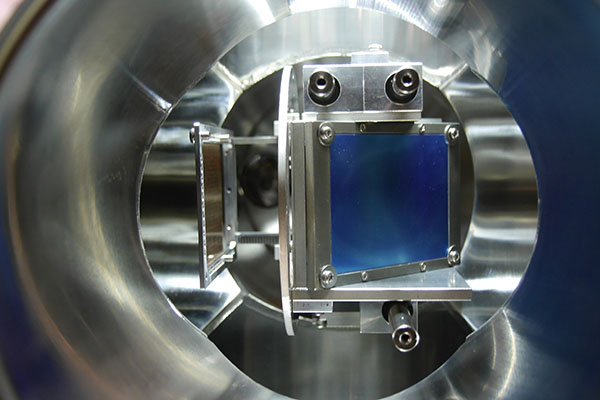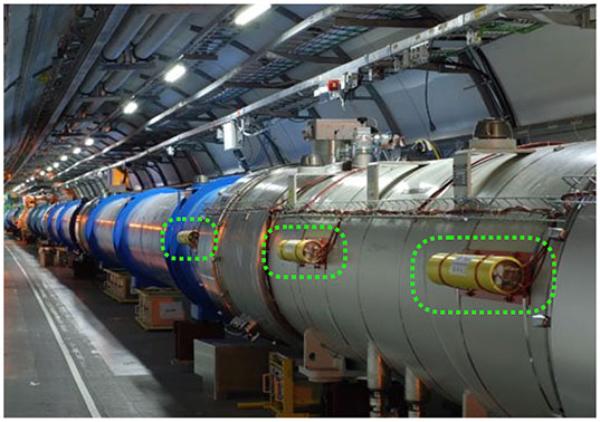Beam Loss Monitoring
Accelerators are designed to make particles follow a designed trajectory, however in a real environment particles may deviate from this path developing into a cascade of secondary particles. These events, known as beam losses, can be detected by observing the radiation levels via particle detectors located outside of the beam vacuum chamber. A Beam Loss Monitoring (BLM) system has three main goals:
- Machine protection. Due to the very high power present in current machines, the loss of a very small fraction of a beam may have a very severe impact on accelerator components. A BLM system observes the beam loss levels and it requests a safe extraction of the beam from the facility if a predefined threshold is exceeded.
- Beam diagnostics. The observation of subtle beam losses is typically a powerful tool for the optimization and fine tuning of the performance of an accelerator.
- Keep activation levels under control. The interaction of particles produced in beam losses with materials will result in activation and subsequent nuclear decay of the generated isotopes. This makes the environment a hazardous place for physicist, engineers or technicians that need to conduct work near acceleration components.

Real-time emittance monitor for low energy heavy ion beams. (Image courtesy: Vasilis Tzoganis)
The Quasar Group is involved in developing BLMs for accelerator and light source applications through our spin-off company D-Beam. The main novelty with regards to beam loss monitoring is the development of so-called optical beam loss monitors. These employ optical fibres and photon sensors to continuously cover large areas of accelerators with high longitudinal precision. This work includes the characterization of a new generation of photon sensors, such as Silicon PhotoMultipliers (SiPM) or Photomultiplier Tubes (PMTs). We are probing the performance of these devices in near saturation conditions to conclude on their applicability for areas like beam loss monitoring where extremely wide dynamic range sensors are required. We are also conducting experiments to determine limitations of sensitivity and dynamic range for BLM systems due to external background sources.

Cap. Ionization Chamber Detectors on LHC
We are also designing radiation-tolerant acquisition electronics for BLMs. Specifically, we are working on:
- ASIC architectures validation, in view of the first foundry prototypes submission. In particular he has developed two discrete components emulation boards of the front-end, one using a charge to frequency converter (CFC) structure and the second one a Delta-Sigma type. These allow to reduce efforts on the system behavior prediction study and parameters tuning.
- Preparing the test bench for the validation of ASICs specifications and reliability.
- Design of the complete radiation tolerant front-end PCB, which shall host: 8 acquisition channels, redundant optical link transmission (based on new generation LpGBT CERN transceivers) and robust power supplies.
- Develop of the signal processing / IIR filtration logic for the back-end, based on the CERN custom acquisition board (VFC-HD).
Currently involved QUASARs:
Joseph, Narender, Monty, Angus, Carsten
Selected publications:
M. King, et al., 'A Systematic Investigation of Beam Losses and Position-Reconstruction Techniques Measured with a Novel oBLM at CLEAR', Instruments 2025, 9(1), 4, https://doi.org/10.3390/instruments9010004
Joseph Wolfenden, et al., 'Cherenkov Radiation in Optical Fibres as a Versatile Machine Protection System in Particle Accelerators', Sensors 2023, 23(4), 2248; https://doi.org/10.3390/s23042248
S. Vinogradov, L. Devlin, E. Nebot del Busto, M. Kastriotou, and C. P. Welsch, 'Challenges of arbitrary waveform signal detection by SiPM in beam loss monitoring systems with Cherenkov fibre readout', Proc. of Science (PoS SISSA) -4 p. (submitted) (2015)
S. Vinogradov, A. Arodzero, R.C. Lanza, and C.P. Welsch, 'SiPM response to long and intense light pulses', Nucl. Instr. Methods A (2015), pp. 148-152; doi:10.1016/j.nima.2014.11.079 (2014.11.079) (2015)
S. Vinogradov, 'Analytical model of SiPM time resolution and order statistics with crosstalk', Nucl. Instr. Methods A (Dec. 2014) (S016890021401451X)
S. Vinogradov et. al, 'SiPM response to long and intense light pulses', Nucl. Instr. Methods A (Dec. 2014) (S0168900214013850)
M. Wendt et al. , 'Status of the CLIC/CTF Beam Instrumentation R&D', Proc. IPAC 2014, Dresden, Germany (2014)
E. Nebot at al. , 'Measurement of Beam Losses at the Australian Synchrotron', Proc. IBIC 2014, Monterrey, USA (2014)
L.J. Devlin, C.P. Welsch, E.N. del Busto, 'Update on Beam Loss Monitoring at CTF3 for CLIC', Proc. IBIC 2013, Oxford, UK (2013)
E.N. del Busto, C.P. Welsch, 'Monte Carlo Simulations of Beam Losses in the Test Beam Line of CTF3', Proc. IBIC 2013, Oxford, UK (2013)
S. Mallows et. al, 'Requirements of a beam loss monitoring system for the CLIC Two Beam Modules', Proc. IPAC, San Sebastian, Spain (2011)
M. Sapinski, B. Holzer, M. Jonker, S. Mallows, T. Otto, C.P. Welsch, 'Requirements of CLIC Beam Loss Monitoring System', Proc. IPAC, Kyoto, Japan (2010)
A. Intermite, M. Putignano, C.P. Welsch, 'Influence of Dark Count on the Performance of Silicon Photomultipliers', Proc. BIW, Santa Fe, NM, USA (2010)
C. Zamantzas, B. Dehning, J. Emery, J. Fitzek, F. Follin, S. Jackson, V. Kain, G. Kruk, M. Misiowiec, C. Roderick, M. Sapinski, 'Configuration and Validation of the LHC Beam Loss Monitoring System', Proc. DIPAC Workshop, Basel, Switzerland (2009)